网络IO模型
网络IO涉及用户空间和内核空间,一般会经历两个阶段:
- 一阶段:等待数据准备就绪,即等待网络数据被copy到内核缓冲区(wait for data)
- 二阶段:将数据从内核缓冲区copy到用户缓冲区(copy data from kernel to user)
上述数据准备就绪可理解为 socket 中有数据到来,根据以上两阶段的不同,出现多种网络 IO 模型,接下来将根据这两阶段来进行分析。
阻塞IO(Blocking IO)
linux 中socket默认blocking,从下图可以看出,用户进程全程阻塞直到两阶段完成,即,一阶段等待数据会阻塞,二阶段将数据从内核copy到用户空间也会阻塞,只有copy完数据后内核返回,用户进程才会解除阻塞状态,重新运行。
结论:阻塞IO,两阶段都阻塞。
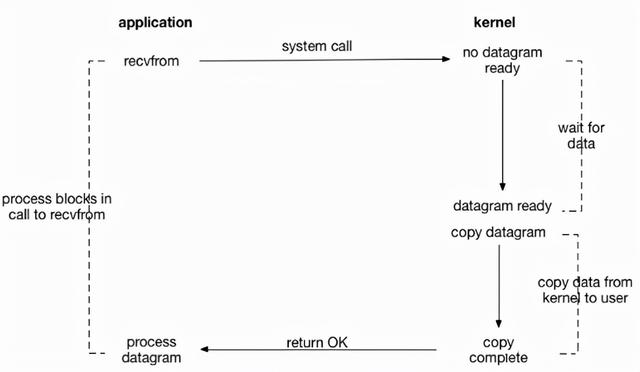
io_blocking
非阻塞IO (Non-blocking IO)
可使用fcntl将socket设置为NON-BLOCKING(fcntl(fd, F_SETFL, O_NONBLOCK);),使其变为非阻塞。如下图,用户进程 recv from时,如果没有数据,则直接返回,因此一阶段不会阻塞用户进程。但是,用户进程需要不断的询问内核数据是否准备好(会造成 CPU 空转浪费资源,因此很少使用)。当数据准备好时,用户进程会阻塞直到数据从内核空间copy到用户空间完成(二阶段),内核返回结果。
**结论:**非阻塞IO一阶段不阻塞,二阶段阻塞。
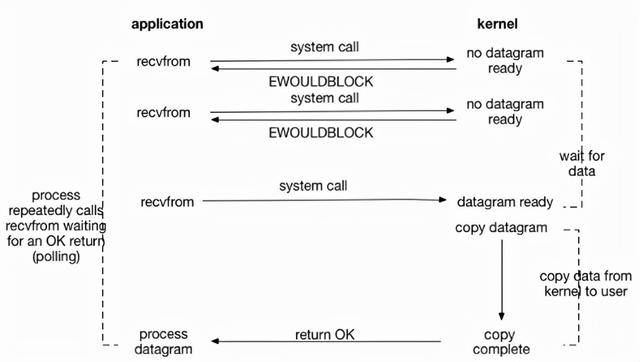
nonblocking_io
图中 recvfrom 返回值含义:
- error of EWOULDBLOCK, 无数据
- 大于0,接收数据完毕,返回值即收到的字节数
- 等于0,连接已经正常断开
- 等于-1, errno 为EAGAIN表示recv操作未完成,否则,表示recv操作遇到系统错误errno.
IO多路复用 (IO multiplexing-select/poll/ Epoll )
也称为事件驱动IO(event driven IO),通过使用select/poll/epoll系统调用,可在单个进程/线程中同时监听多个网络连接的socket fd,一旦有事件触发则进行相应处理,其中select/poll/ epoll 本身是阻塞的。(IO多路复用后面会用专门文章来详细讲解)
**结论:**两阶段都处于阻塞状态,优点是单个 线程 可同时监听和处理多个网络连接
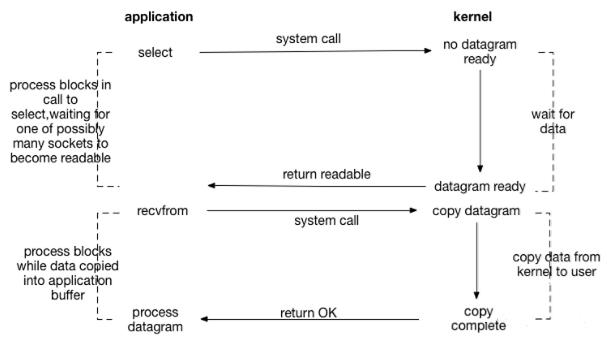
io_multiplexing
信号驱动IO (signal driven IO, SIGIO)
通过sigaction系统调用,建立起signal-driven I/O的socket,并绑定一个信号处理函数;sigaction不会阻塞,立即返回。
当数据准备好,内核就为进程产生一个SIGIO信号,随后在信号处理函数中调用recvfrom接收数据。
**结论:**一阶段不阻塞,二阶段阻塞
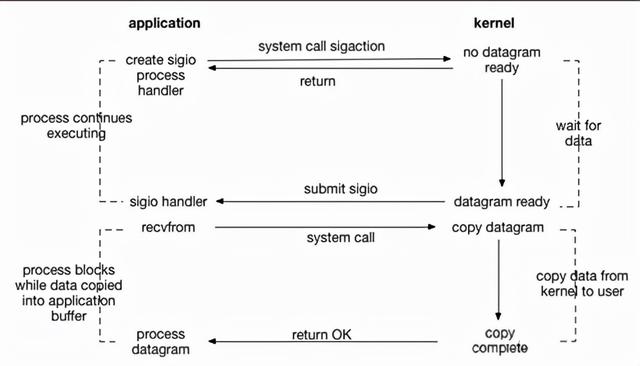
sigio
以上四种模型都有一个共同点:二阶段阻塞,也就是在真正IO操作(recvfrom)的时候需要用户进程参与,因此以上四种模型均称为同步IO模型。
相关视频推荐
学习地址:
需要C/C++ Linux服务器架构师学习资料加qun812855908获取(资料包括 C/C++,Linux,golang技术, Nginx ,ZeroMQ,MySQL, Redis ,fastdfs, MongoDB ,ZK,流媒体, CDN ,P2P,K8S, Docker ,TCP/IP,协程,DPDK, ffmpeg 等),免费分享

异步IO (Asynchronous IO)
POSIX 中提供了异步IO的接口aio_read和aio_write,如下图,内核收到用户进程的aio_read之后会立即返回,不会阻塞,aio_read会给内核传递文件描述符,缓冲区指针,缓冲区大小,文件偏移等;当数据准备好,内核直接将数据copy到用户空间,copy完后给用户进程发送一个信号,进行用户数据异步处理(aio_read)。因此,异步IO中用户进程是不需要参与数据从内核空间copy到用户空间这个过程的,也即二阶段不阻塞。
结论:两阶段都不阻塞
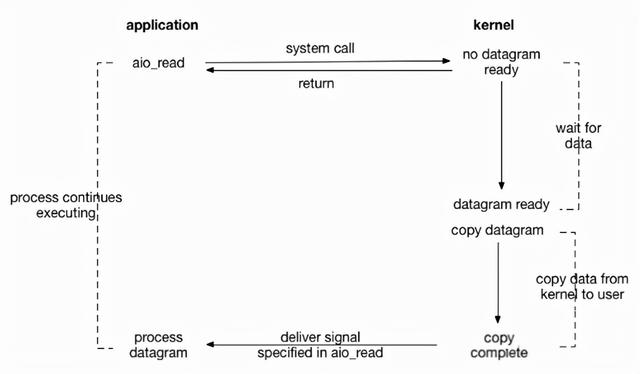
aysnchronous_io
上述五种IO模型对比
从上述分析可以得知,阻塞和非阻塞的区别在于内核数据还没准备好时,用户进程是否会阻塞(一阶段是否阻塞);同步与异步的区别在于当数据从内核copy到用户空间时,用户进程是否会阻塞/参与(二阶段是否阻塞)。以下为五种IO模型的对比图,可以清晰看到各种模型各个阶段的阻塞情况。
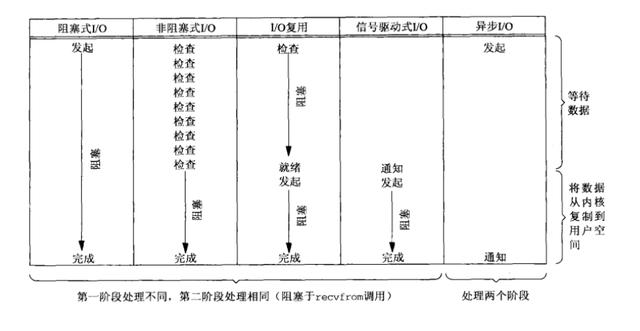
five_ios
以下为Richard Stevens对同步和异步IO的描述,可以把I/O operation是否阻塞看作为两者的区别。
“
POSIX defines these two terms as followers:
A synchronous I/O operation causes the requesting process to be blocked until that I/O operation completes;
An asynchronous I/O operation does not cause the requesting process to be blocked;
”
还有一个概念需要区分:异步IO和IO异步操作,IO异步操作其实是属于同步IO模型。
io_uring
POSIX中提供的异步IO接口aio_read和aio_write性能一般,几乎形同虚设,很少被用到,性能不如Epoll等IO 多路复用 模型。
Linux 5.1引入了一个重大feature:io_uring,由block IO大神Jens Axboe开发,这意味着Linux native aio的时代即将称为过去,io_uring的异步IO新时代即将开启。
以下贴出Jens Axboe的测试数据
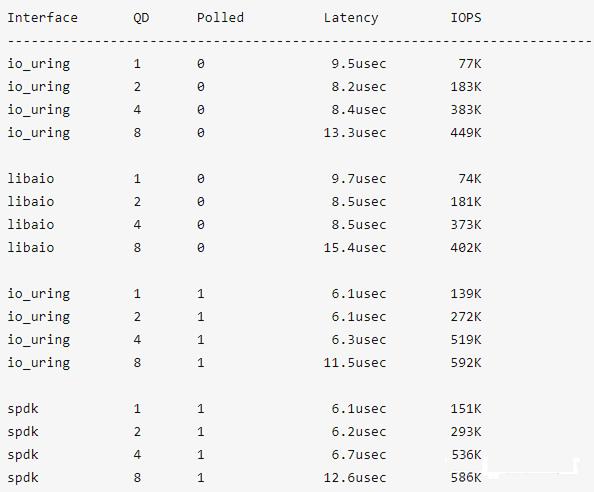
io_uring_data
从以上数据看出,在非 Polling 模式下,io_uring性能提升不大,但是polling模式下,io_uring性能远远超出libaio,并接近spdk.
io_uring围绕高效进行设计,采用一对共享内存ringbuffer用于应用和内核间通信,避免内存拷贝和系统调用(感觉这应该是io_uring最精髓的地方):
- 提交队列(SQ):应用是IO提交的生产者,内核为消费者
- 完成队列(CQ):内核是完成事件的生产者,应用是消费者
io_uring系统调用相关接口
// 1. 初始化阶段
// The io_uring_setup() system call sets up a submission queue (SQ) and completion queue (CQ)
// returns a file descriptor which can be used to perform subsequent operations on the io_uring instance
// The submission and completion queues are shared between userspace and the kernel
// which eliminates the need to copy data when initiating and completing I/O
// 其中SQ, CQ为ringbuffer.
// io_setup返回一个fd,应用程序使用这个fd进行 mmap ,和 kernel 共享一块内存
int io_uring_setup(u32 entries, struct io_uring_ params *p);
// IO提交的做法是找到一个空闲的 SQE,根据请求设置 SQE,并将这个 SQE 的索引放到 SQ 中
// SQ 是一个典型的 RingBuffer,有 head, tail 两个成员,如果 head == tail,意味着队列为空。
// SQE 设置完成后,需要修改 SQ 的 tail,以表示向 RingBuffer 中插入一个请求。
/*
* initiate and/or complete asynchronous I/O
* io_uring_enter() is used to initiate and complete I/O using the shared submission and completion
* queues setup by a call to io_uring_setup(2). A single call can both submit new I/O and wait for
* completions of I/O initiated by this call or previous calls to io_uring_enter().
*/
int io_uring_enter(unsigned int fd, unsigned int to_submit,
un sig ned int min_complete, unsigned int flags,
sigset_t *sig);
/*
* register files or user buffers for asynchronous I/O
* The io_uring_register() system call registers user buffers or files for use in an io_uring(7) instance
* referenced by fd. Registering files or user buffers allows the kernel to take long term references to
* internal data structures or create long term mappings of application memory, greatly reducing * per-I/O overhead .
*/
int io_uring_register(unsigned int fd, unsigned int opcode,
void *arg, unsigned int nr_args)
liburing
为方便使用,Jens Axboe还开发了一套liburing库,用户不必了解诸多细节,简单example如下
/* setup io_uring and do mmap */
io_uring_queue_init(ENTRIES, ˚, 0);
/* get an sqe and fill in a READV operation */
sqe = io_uring_get_sqe(˚);
io_uring_prep_readv(sqe, fd, &iovec, 1, offset);
/* tell the kernel we have an sqe ready for consumption */
io_uring_submit(˚);
/* wait for the sqe to complete */
io_uring_wait_cqe(˚, &cqe);
/* read and process cqe event */
io_uring_cqe_seen(˚, cqe);
/* tear down */
io_uring_queue_exit(˚);
通过全新的设计,共享内存,IO 过程不需要系统调用,由内核完成 IO 的提交, 以及 IO completion polling 机制,实现了高IOPS,高 Bandwidth 。相比 kernel bypass,这种 native 的方式显得友好一些。


